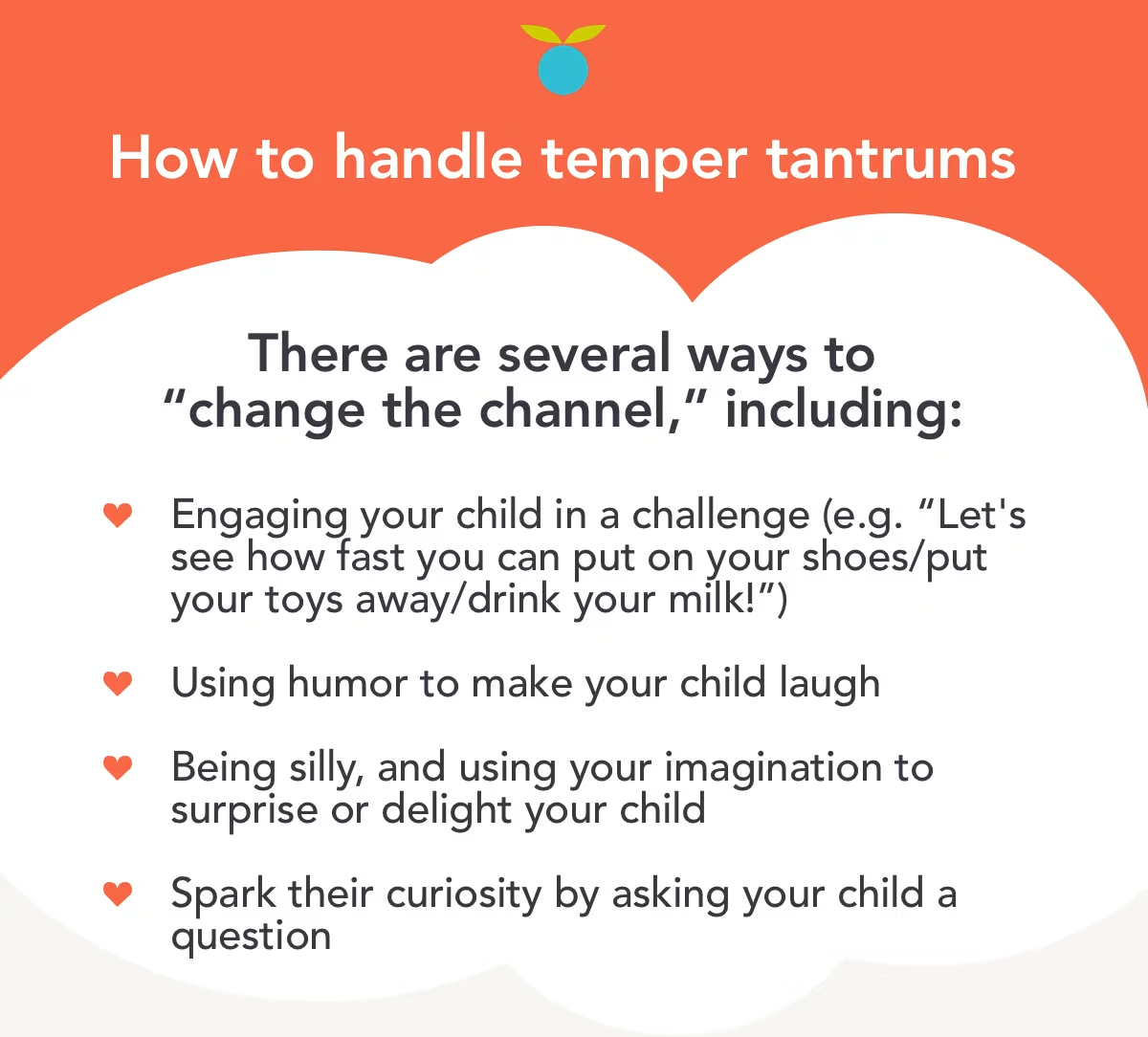7 ways to deal with toddler temper tantrums
Updated Oct 02, 2025

Temper tantrums are a hallmark of early childhood. While they can be challenging for both young children and parents, they’re also a normal and necessary part of social and emotional development.
Learn what a temper tantrum is, what causes them, how to prevent tantrums, and some helpful tips on how to handle toddler tantrums without losing control of your own temper.
Table of Contents
What is a temper tantrum?
We’ve all been there: you’re in the park, and it’s time to go. Up until this point, leaving places hasn’t been an issue for your normally sweet and compliant 15 month old: not this time. You tell your child that it’s time to leave, and they throw themself on the ground, screaming their new favorite word: “NOOOO!”
It’s finally happened. Your child is throwing a tantrum, their very first tantrum. Welcome to toddlerhood!
While there’s no single definition of what a temper tantrum is, it can be understood as an intense, emotional outburst, which seemingly comes out of nowhere. It always involves a combination of internal stressors (e.g. hunger, fatigue, frustration, etc.) and/or external stressors (e.g. transitioning from a fun activity to a less fun activity) that overwhelms the child’s capacity to effectively cope with a given situation. Tantrums also occur as children start developing independence, and want to feel a sense of control over what happens in their world.
What causes temper tantrums in toddlers?
Temper tantrums occur because the “higher” part of the brain that’s responsible for managing emotional reactions to stress (i.e. the prefrontal cortex) hasn’t yet developed in young children. Therefore, anything that causes moderate to extreme levels of stress in young children can trigger a temper tantrum. While some children experience small temper tantrums throughout the day that are quick to come and go, other children experience extreme tantrums, where it is harder for them to calm down and get back to a state of emotional regulation.
Some common reasons why toddlers have temper tantrums include:
Being told no: While toddlers need limits in order to stay safe, they don’t like it when they’re imposed upon them. Being told that they can’t have, or do, something is one of the most common tantrum triggers.
Transitioning: Transitioning from one activity to the next can be stressful for toddlers. Tantrums are particularly likely to occur during transitions that involve moving from a fun activity (e.g. watching a show) to a less fun activity (e.g. eating dinner).
Feeling frustrated: Toddlers are all about wanting to do things on their own and experience a sense of control. However, oftentimes they aren’t yet developmentally capable of doing what they want to do. This mismatch between desire and ability leads to feelings of frustration, which often results in your little one throwing a tantrum.
Anxiety: Anxiety is another common reason behind toddler temper tantrums. An unexpected event, lack of routine, or unrealistic demand (e.g. expecting the child to do something they’re incapable of doing) can cause a toddler to feel anxious, and in turn, have temper tantrums.
Hunger and fatigue: Toddlers are particularly susceptible to temper tantrums when their physical needs haven’t been met. For this reason, skipped meals and/or poor naps are frequent causes of children's temper tantrums.
Lack of stimulation: Toddlers get bored easily. Not getting enough physical exercise and/or opportunities to play and socialize can lead to temper tantrums. Toddlers have short attention spans, so switching up the activities is a great way to keep them busy and prevent tantrums.

Are tantrums a sign of something?
Your toddler throwing a tantrum is an indication that they are feeling overwhelmed by something that is happening within their body (e.g. hunger) and/or their environment (e.g. being asked to tidy up when they would rather play). Temper tantrums aren’t a sign of defiance or misbehavior, but rather a cry for help.
Think of a screaming tantrum as your toddler’s normal and developmentally appropriate way of expressing their need for your assistance in regulating their emotions and behaviors.
In the same way, infants use crying to get their parents’ comfort and attention or communicate that they are in discomfort, toddlers use tantrums. However, because tantrums may involve yelling, screaming, hitting, and other challenging behaviors, they often trigger a negative reaction in parents rather than a soothing response.
To make matters worse, toddlers usually reject their parents’ efforts to help them when they are in the midst of a tantrum. In their inconsolable emotional state, toddlers simultaneously need but don’t want their parents’ assistance with managing their emotions. This often leaves parents confused and at a loss for what to do, but not all is lost!
How to prevent tantrums
It is impossible to avoid your toddler throwing a tantrum, but there are some things you can do to prevent tantrums or minimize them. Let’s look at these three steps:
IDENTIFY: Keep a note of what your child’s tantrum triggers are. Do they have trouble transitioning from one activity to the next? Or do they seem to have extreme tantrums when they are told they can’t do something?
ANTICIPATE: Once you identify what provokes an intense emotional response from your child, make an effort to anticipate transitions or limits before they happen. Visual routines or timers are a great way to help your child navigate through transitions and know what to expect from a situation with ease.
CONNECT: Responding to a tantrum is all about helping your child transition their feelings of frustration. We all do better when we feel better, so make sure that you are having enough one-on-one time with your toddler so that when the time comes to enforce limits and teach skills, their emotional needs have already been met.
7 ways to handle temper tantrums
While temper tantrums are a normal and developmentally appropriate part of early childhood development, it doesn’t mean that parents should just allow their toddlers to act however their emotions dictate—particularly if they exhibit destructive or aggressive behaviors during their tantrums.
Instead, parents can use their toddlers’ temper tantrums as them how to manage their emotions more appropriately. By parents stepping in to help their toddlers regulate their emotional reactions, toddlers eventually learn to self-regulate or manage their feelings, impulses, and behaviors on their own. This takes time, repetition, and lots of patience on the part of parents.
Editor's note
Toddler temper tantrums can’t - and shouldn’t - be avoided. Research shows that suppressing emotional outbursts in early childhood using fear-based forms of discipline leads to anger management issues later on in life. There are several strategies parents can use to handle toddler tantrums more effectively, helping both yourself and your child.
1. Minimize stress
While preventing temper tantrums isn’t always possible, making sure that your toddler’s physical needs are met (e.g. nutrition, sleep, and exercise) is the surest way to minimize the risk of them occurring in the first place. Maintaining a predictable schedule is also important, as it allows your toddler to know what’s going to happen each day, thereby reducing their stress levels.
2. Model calm
Because toddler tantrums can often be volatile, it’s common for tantrums to trigger an emotional response in parents. However, if you respond to a tantrum with your own intense emotions, this is like adding fuel to an already raging fire. It's okay for you to take a few moments to breathe and calm down before responding to your child’s tantrums.
3. Label feelings
Research shows that the more words children have to describe their feelings, the less tantrums they have. Labeling your child’s feelings (until they can do this for themselves) teaches them the emotional vocabulary they need to both process and express their feelings. Empathizing with your child’s feelings when they’re having a tantrum further decreases the intensity of their emotions.
4. Change the channel
When toddlers get stuck in negative emotions, it’s often helpful to redirect their attention towards something more positive or neutral. The goal here is to get them out of the “feeling” part of their brain, and into the “thinking” part of their brain.

5. Give time and space
As infants grow into toddlers, and then preschoolers, they often start rejecting their parents’ efforts to comfort them when they are upset. This is partially due to their developmentally appropriate need to begin “self-soothing,” or providing comfort to themselves, rather than relying on their parents.
If your child recoils in response to your efforts to comfort them, allow them to move away from you, empathize with their feelings, and let them know you’re available if/when they want help calming down.
6. Provide two acceptable choices
When asking toddlers to do something they don’t want to do, it can be helpful to provide them with choices. Fostering their need for control. For example, if you want your toddler to put on their socks, ask them if they would like to put their socks on with your help, or all by themselves.
Allowing your child to make a decision between two good options (that you’ve chosen), gives them a sense of power and control, which makes them much less likely to throw a tantrum in response to your request.
7. Planned ignoring
Parental attention is a powerful motivator for young children. Therefore, removing your attention from an irritating behavior decreases the behavior. Planned ignoring is different from regular ignoring in that parents are aware of the behavior, and purposefully ignore it, rather than simply not paying attention to their child. Planned ignoring can be useful for milder tantrums, which don’t require more intense intervention (such as labeling feelings or changing the channel) from parents.
When should I worry about temper tantrums?
Temper tantrums are a normal and necessary part of development in early childhood. However, if your child regularly has major meltdowns after the age of 5 years old, it may be an indication of atypical brain development.
When young children continue to have severe temper tantrums after the preschool years, it's usually because they’re experiencing stress overload caused by their inability to filter and/or process stimulation from their environment properly. This could be due to a variety of reasons, including ADHD, anxiety, learning disorders, sensory processing issues, and autism.
Parents should seek consultation with a pediatrician or child psychologist about their kid’s tantrums if their child is older than five, and having tantrums that are:
Severe in nature: Involving physical aggression towards self or others, and/or the deliberate destruction of property.
Long-lasting: Take more than 15 minutes to blow over.
Frequent: Occur multiple times per week.
Dangerous: Involve breath-holding or physical thrashing that can result in injury.
At what age group are temper tantrums most common?
Temper tantrums are most common between 2 - 5 years old, but can begin as early as 1, and may continue up to and after the preschool years.

Tantrums at 1 - 2 years old (12 - 24 month tantrums)
Tantrums mostly involve crying and back arching. The most helpful technique at this age is picking your child up and physically soothing them.
Redirecting your child’s attention away from what they’re upset about also works well. For example, if your child is throwing a tantrum because you won’t allow them to explore an unsafe object or area, redirect their attention toward an alternative object or area that’s safe to explore.
Tantrums at 2 - 3 years old (24 - 36 month tantrums)
As your baby grows from a toddler into a preschooler, their memory improves, making redirection a much less helpful technique for dealing with tantrums. However, with improved memory comes increased language skills, which help young children to process and express their emotions more effectively.
Labeling your child’s emotions and empathizing with what they’re upset about teaches them that when they put their feelings into words, they’ll get their needs met and be better understood. Children at this age may also still require holding them to calm them down, as physical aggression peaks at this age.
Tantrums at 3 - 4 years old
Your preschooler should be getting more skilled at expressing their feelings verbally, however, they still need lots of assistance regulating their emotions, even if they seem to reject your help while they’re in the midst of a tantrum.
Giving them lots of time and space to calm down is a helpful technique at this age. At the same time, make sure your child knows that you’re there for them by offering a hug when and if they’d like to help calm down.
Tantrums at 4 - 5 years old
By the time your child reaches the ages of 4 and 5, they should be able to put their feelings into words, as well as develop tools to help calm themselves down.
Children at this age can be coached to use breathing exercises, progressive relaxation, simple yoga postures, and other self-regulation strategies when they begin to feel frustrated, angry, or agitated. Setting up a “calm down corner” or a special place for your child to go to whenever they need to calm down can be helpful at this age.
Takeaway
What is a temper tantrum?
A temper tantrum is when a toddler or young child shows an intense emotional outburst in response to a situation that is out of their control and/or when a need is unmet. Since small children aren’t capable of fluidly navigating and communicating their emotions, tantrums range from whining and crying to physical behaviors like kicking and hitting.
What causes a tantrum?
A toddler may throw a tantrum when a limit is being imposed (being told “no), when they have to transition out of a fun activity, or when they are hungry, tired, or feel emotionally disconnected from their caregivers. Tantrums can also be caused by constant changes in routines and lack of stimulation. Since toddlers are beginning to experience a sense of control and independence, tantrums can also be caused by the frustration of not being able to do something on their own.
How to prevent a temper tantrum
While it is not always possible to prevent a temper tantrum, identifying tantrum triggers and anticipating transitions are helpful strategies to prevent and minimize tantrums. Identify what situations or at which times of the day your child experiences tantrums, and help prevent them by making sure their physical needs are met, building skills, and anticipating transitions or changes in routine.
How to handle a temper tantrum
The goal of parental intervention during a temper tantrum is to help get your child back to a regulated state. The most important thing is to remain calm in order to model what calm looks like for your child. Validate their emotions, help them name their feelings, and redirect their attention to something else if needed. If your child asks for space, respect their wishes and give them time to regulate on their own.
Toddler temper tantrums FAQ
Share article:
Note: The content on this site is for informational purposes only and should not replace medical advice from your doctor, pediatrician, or medical professional. If you have questions or concerns, you should contact a medical professional.
Table of Contents
Share article:







